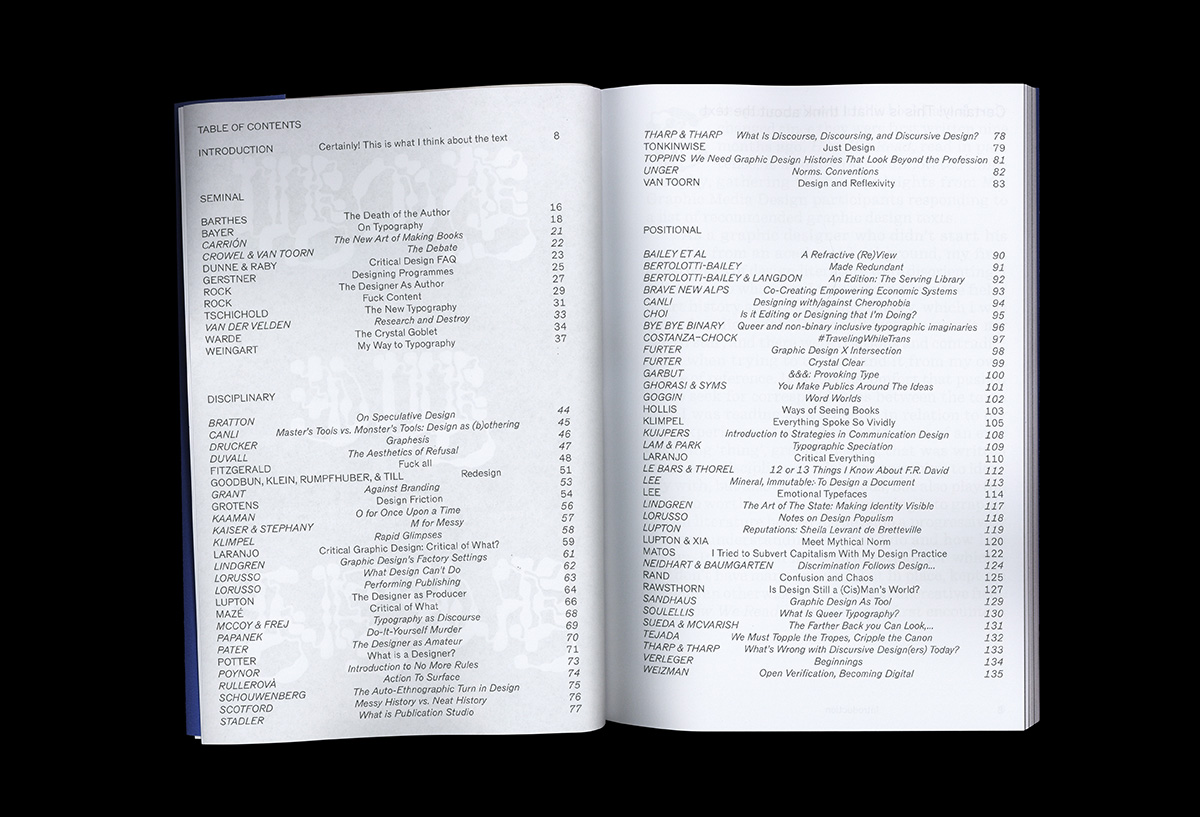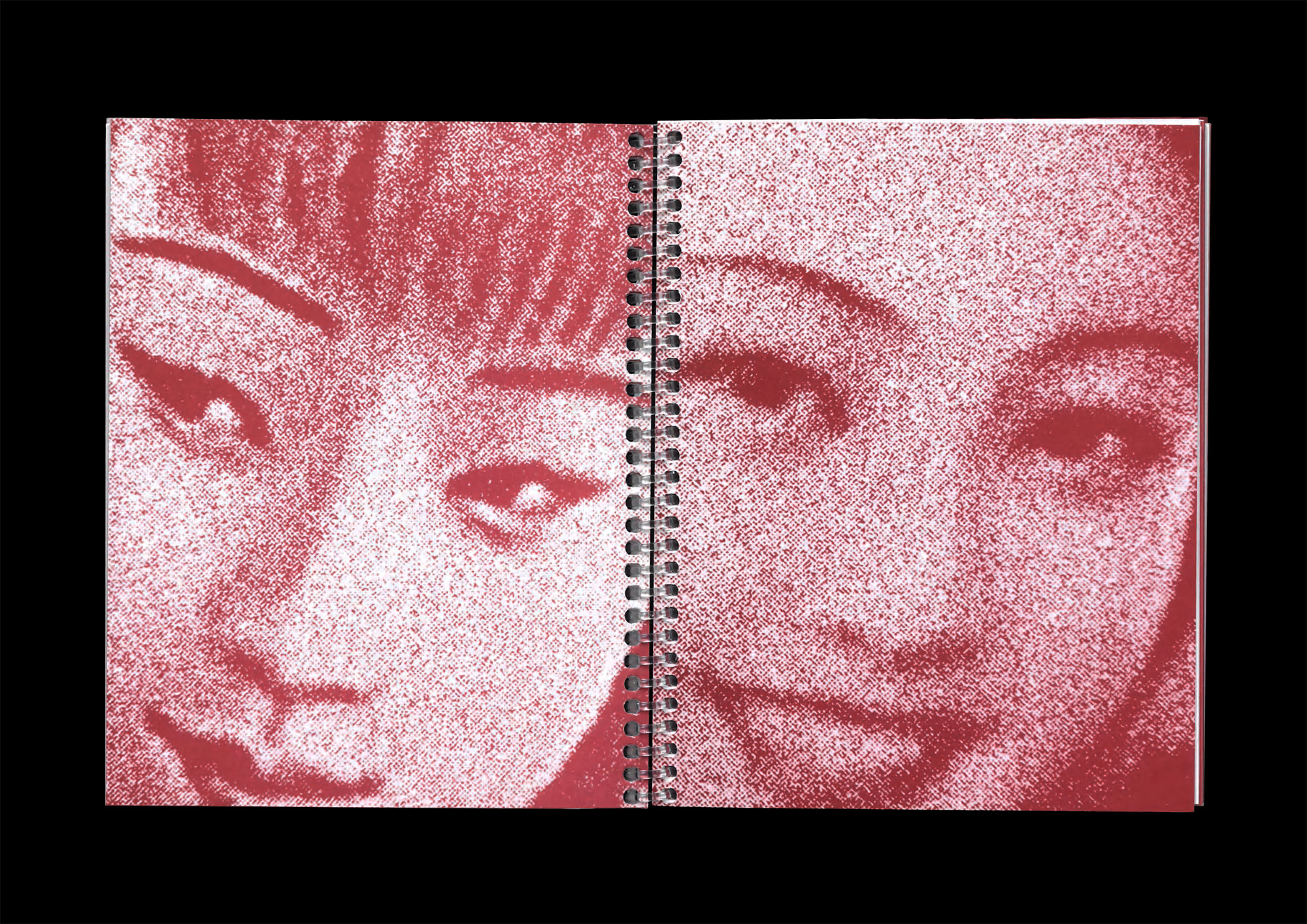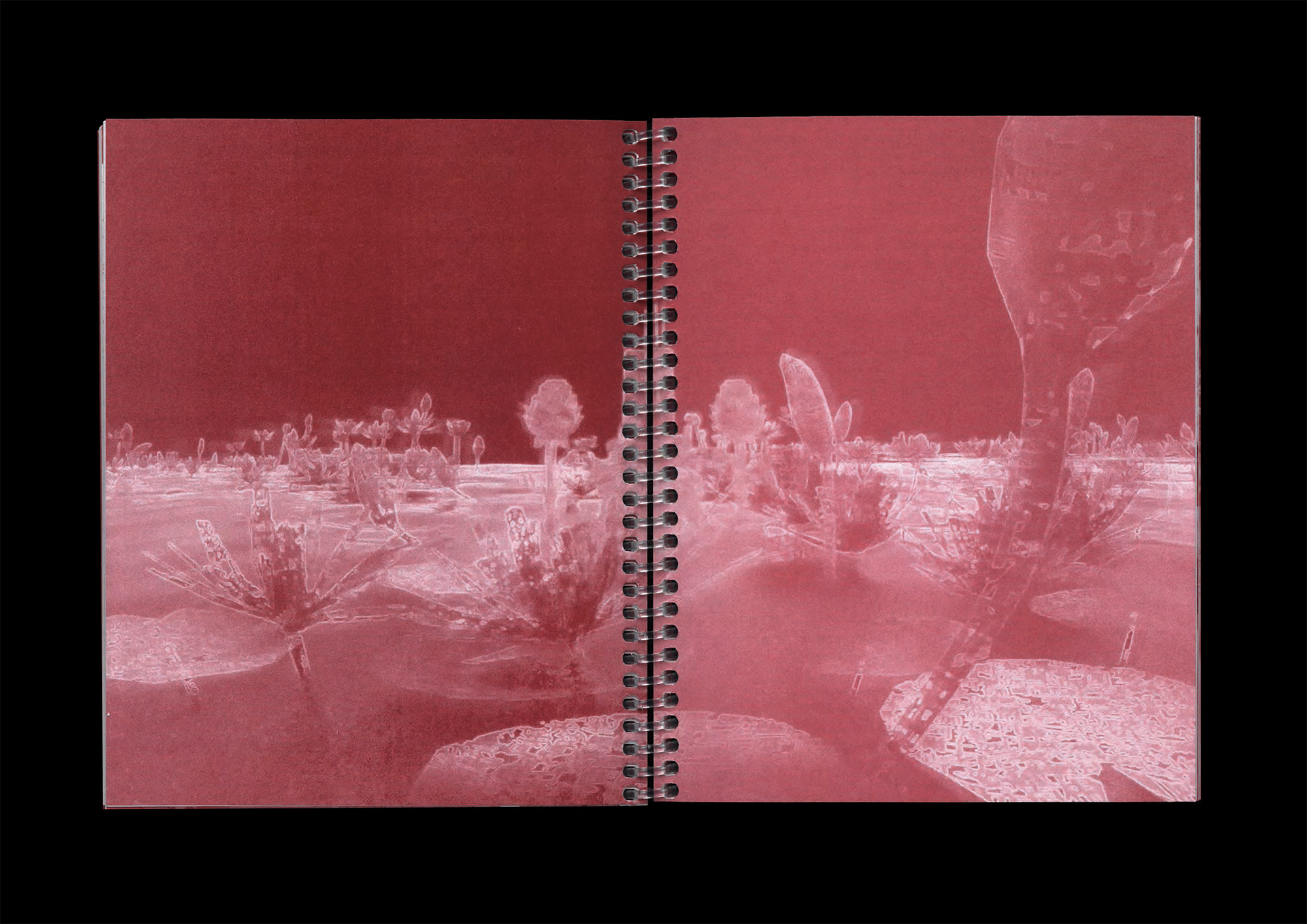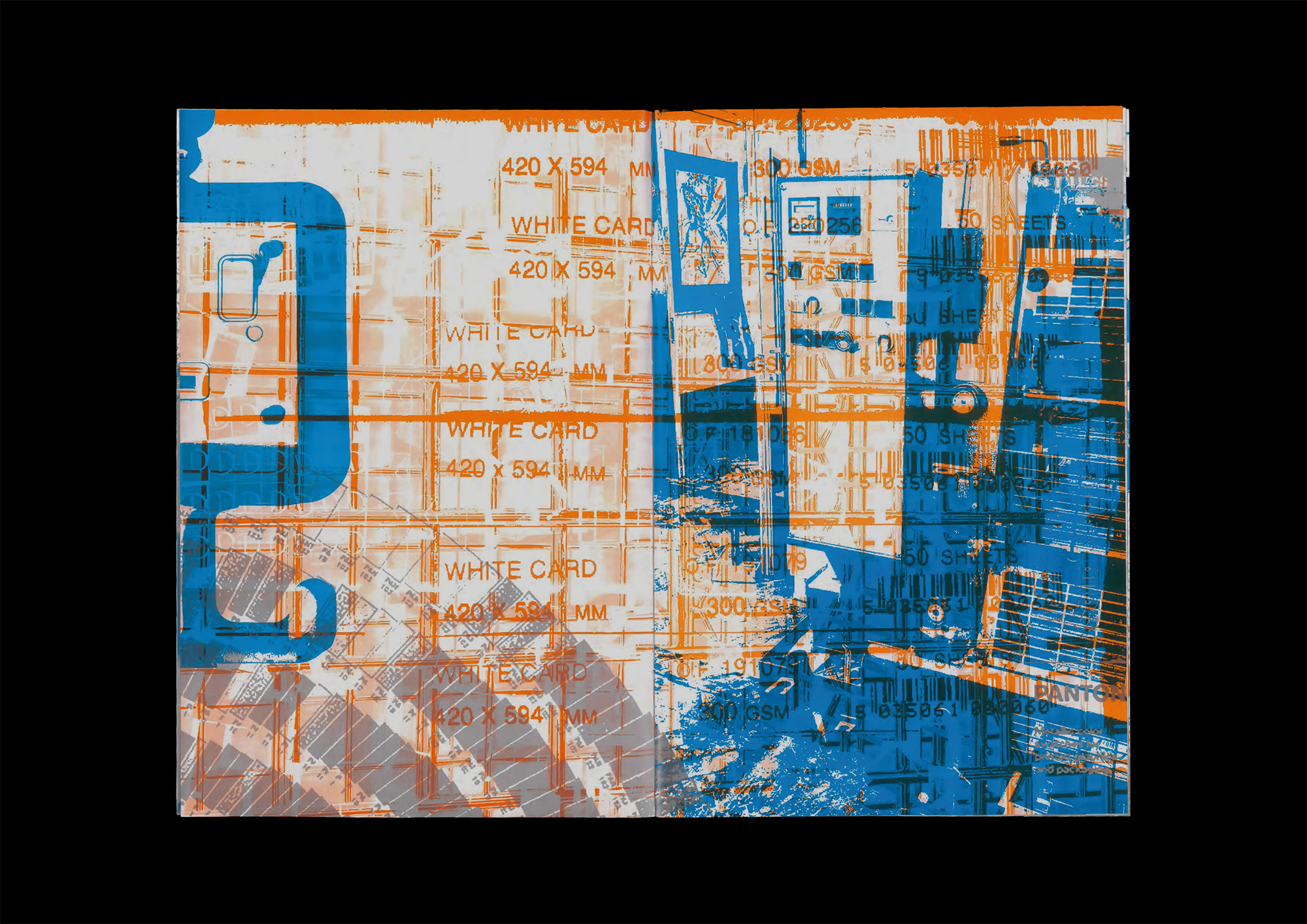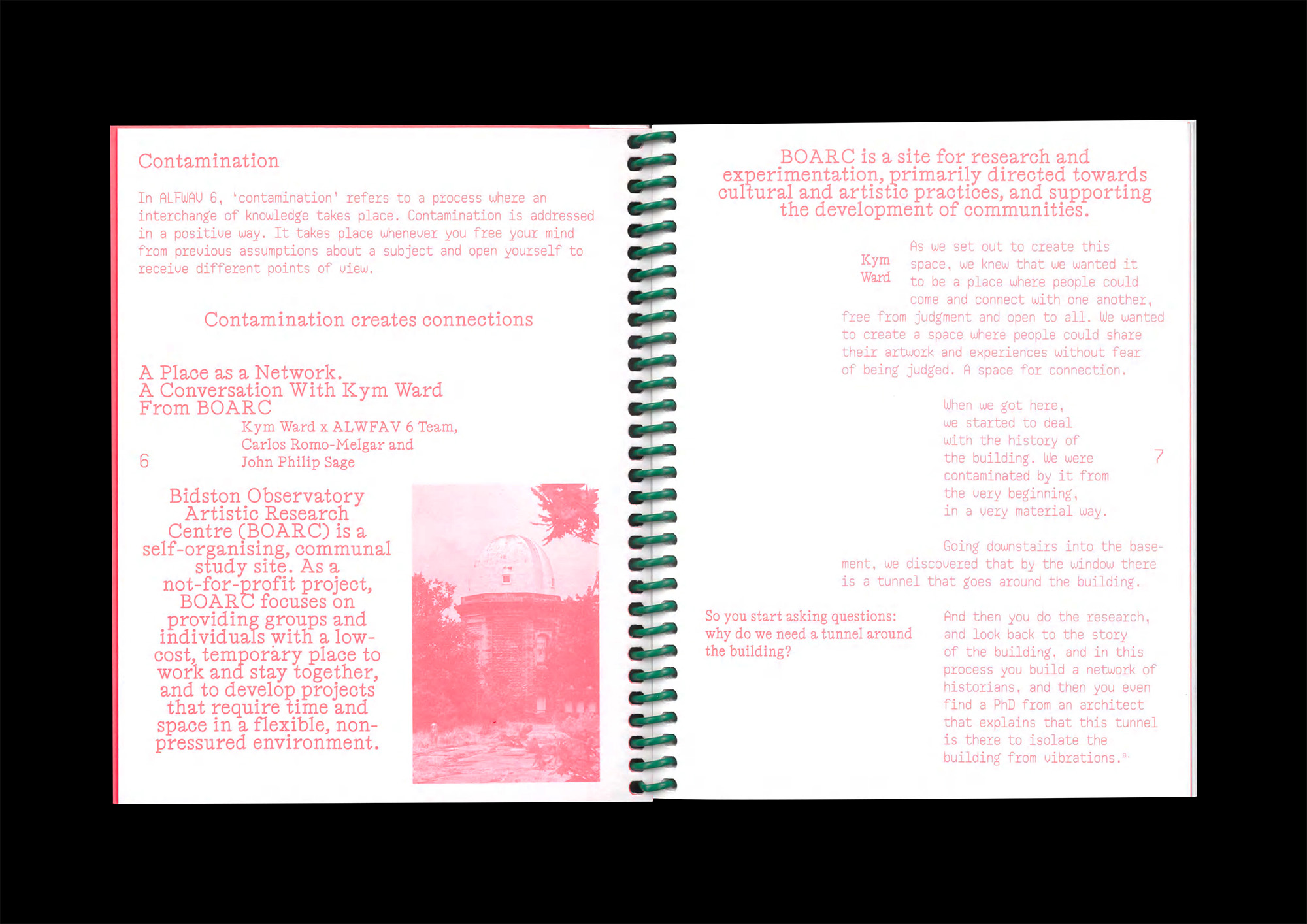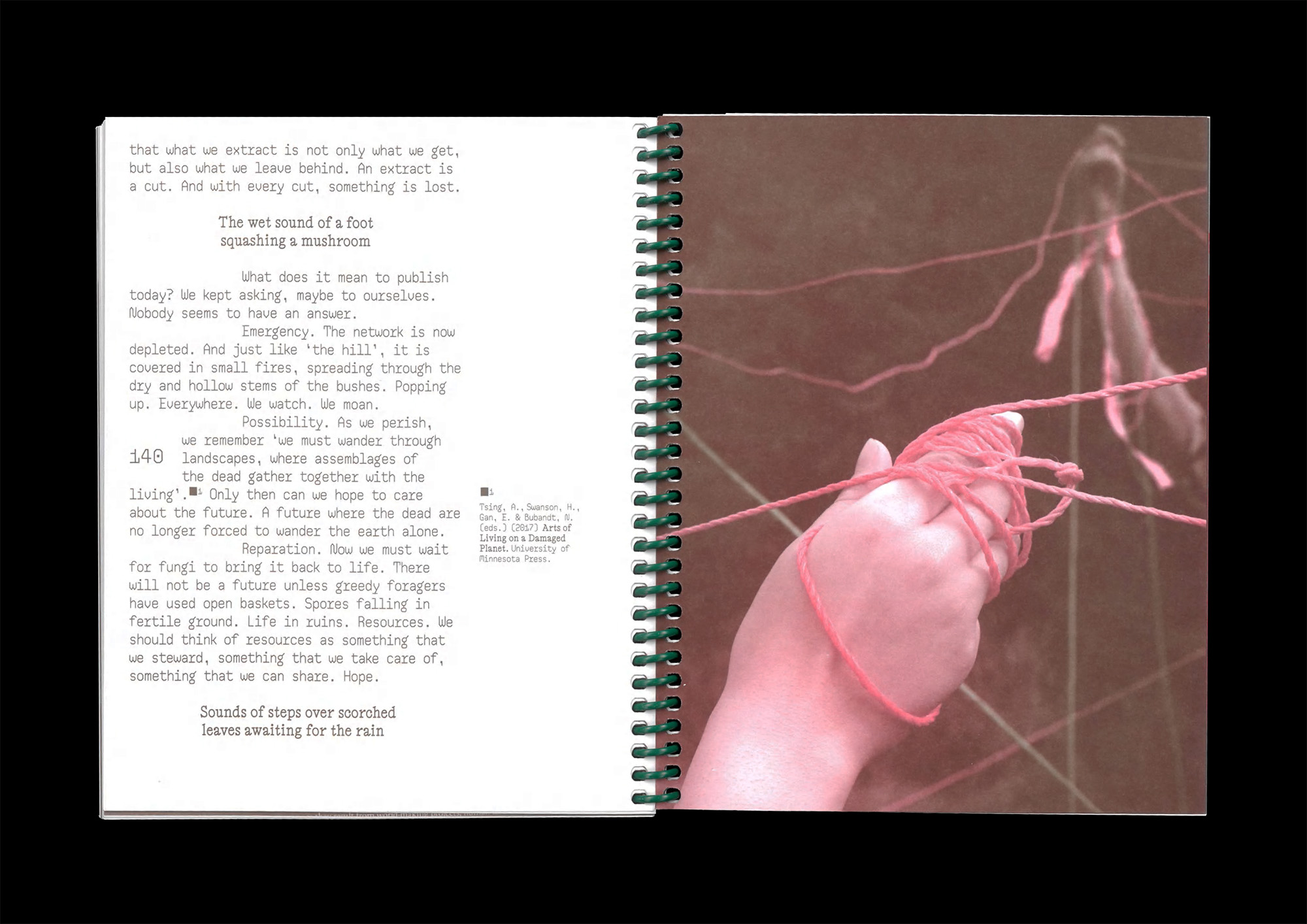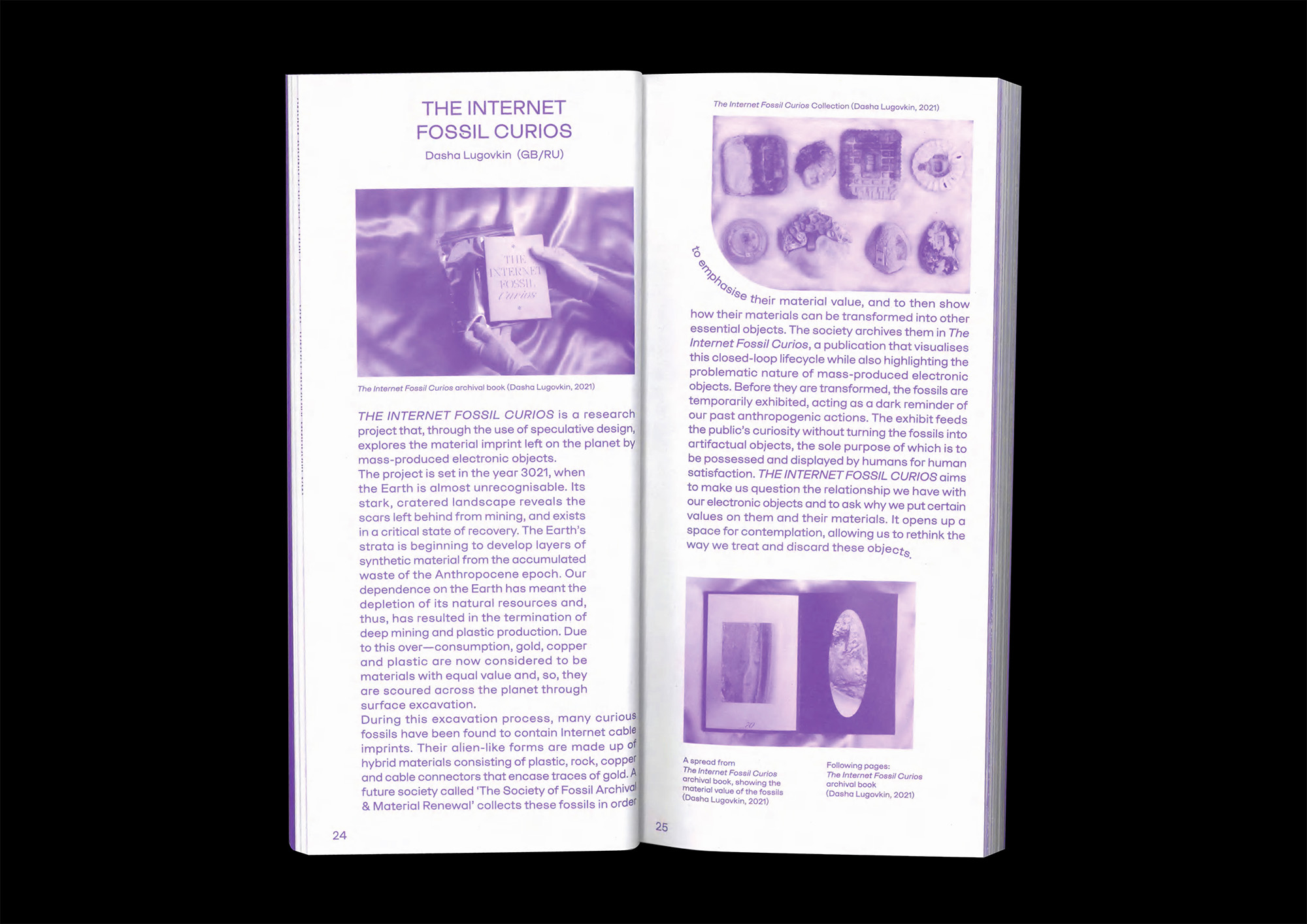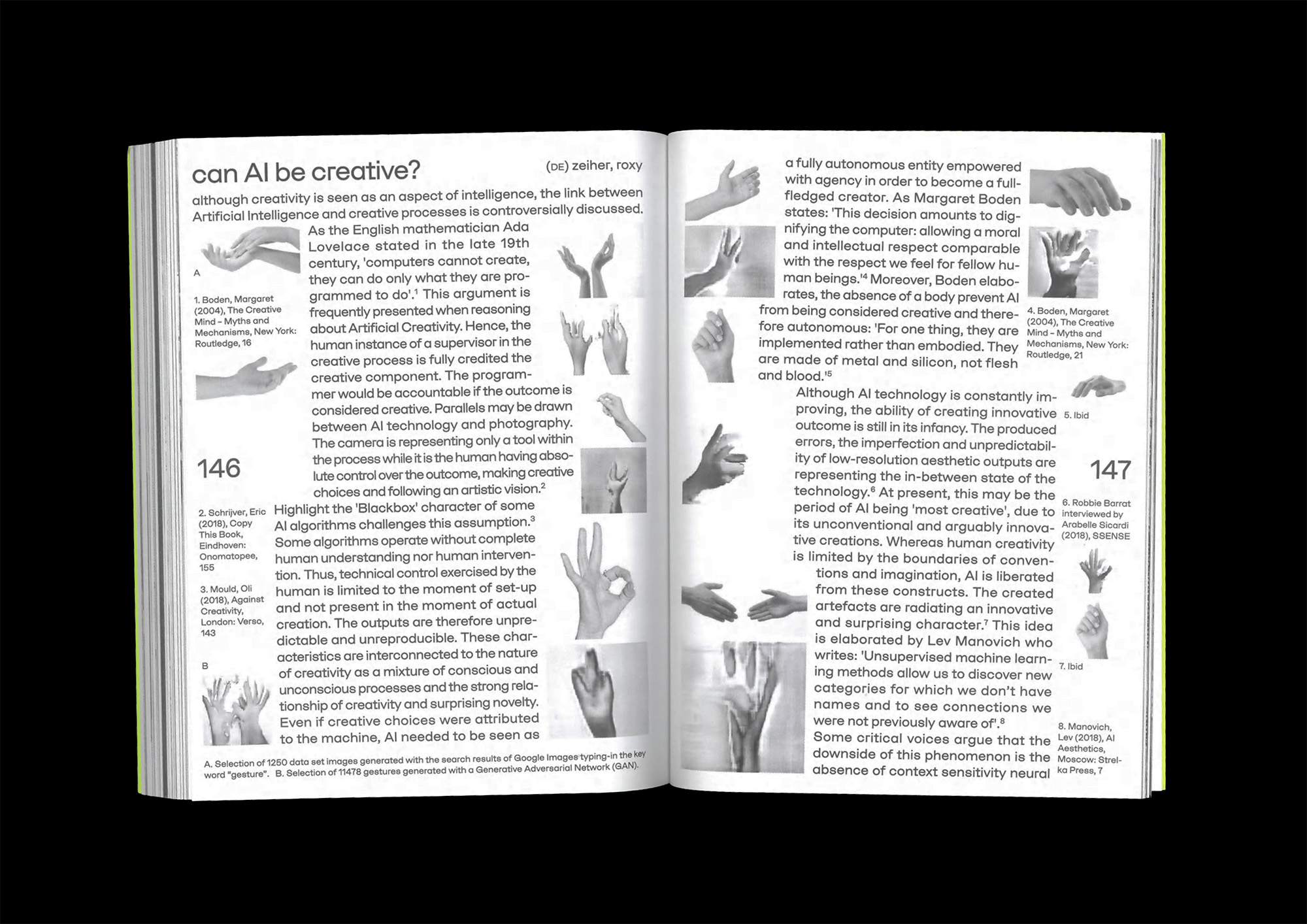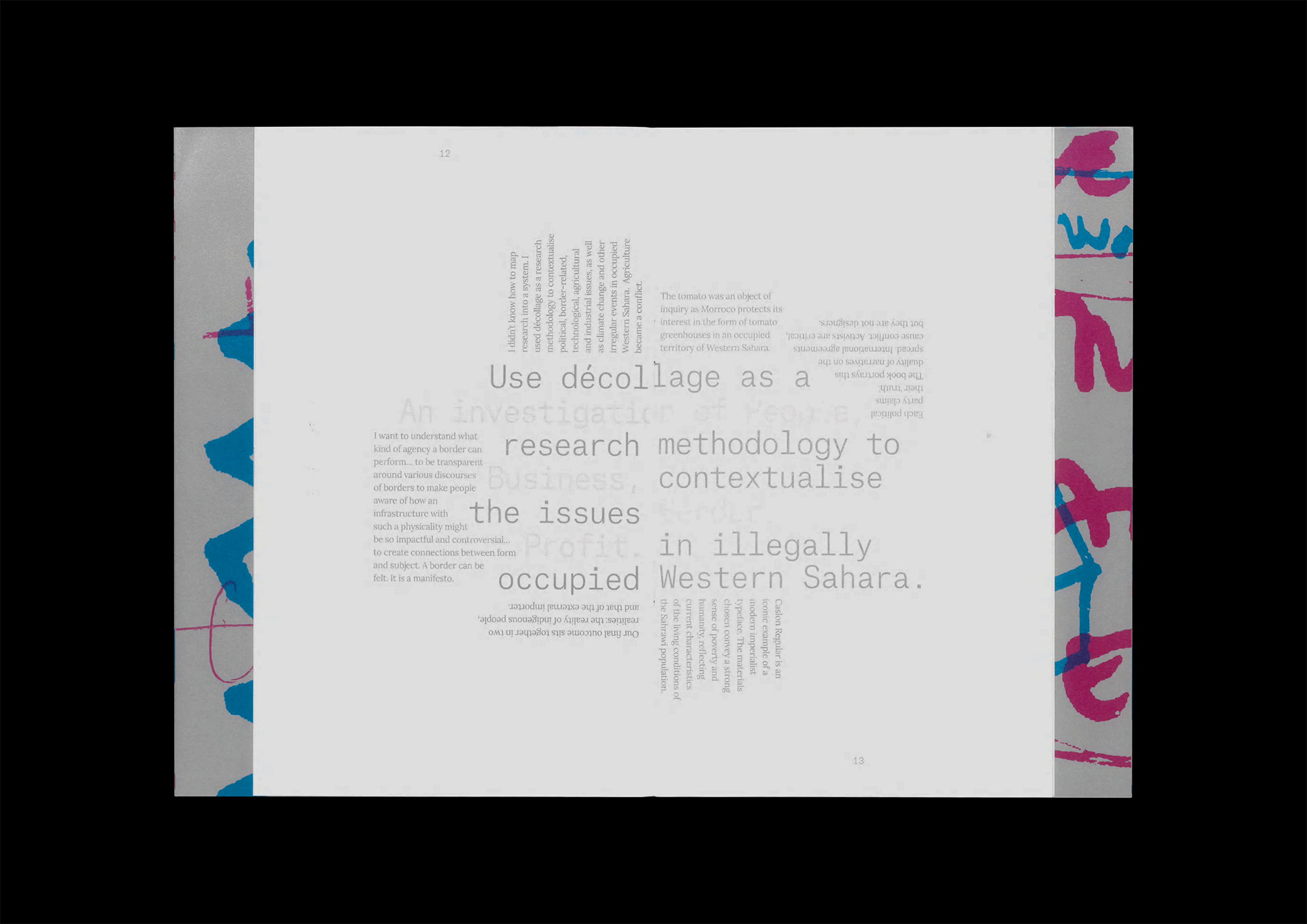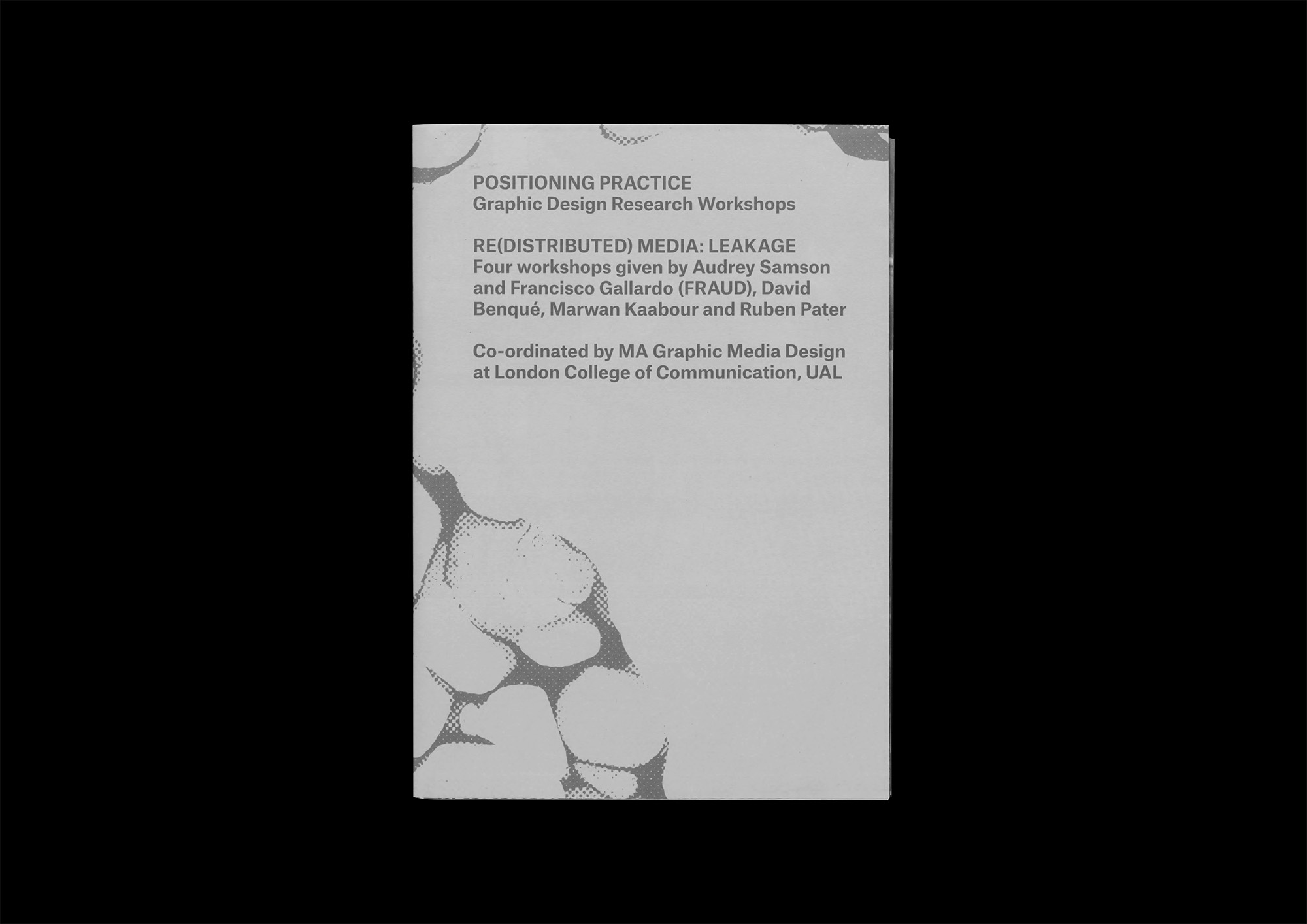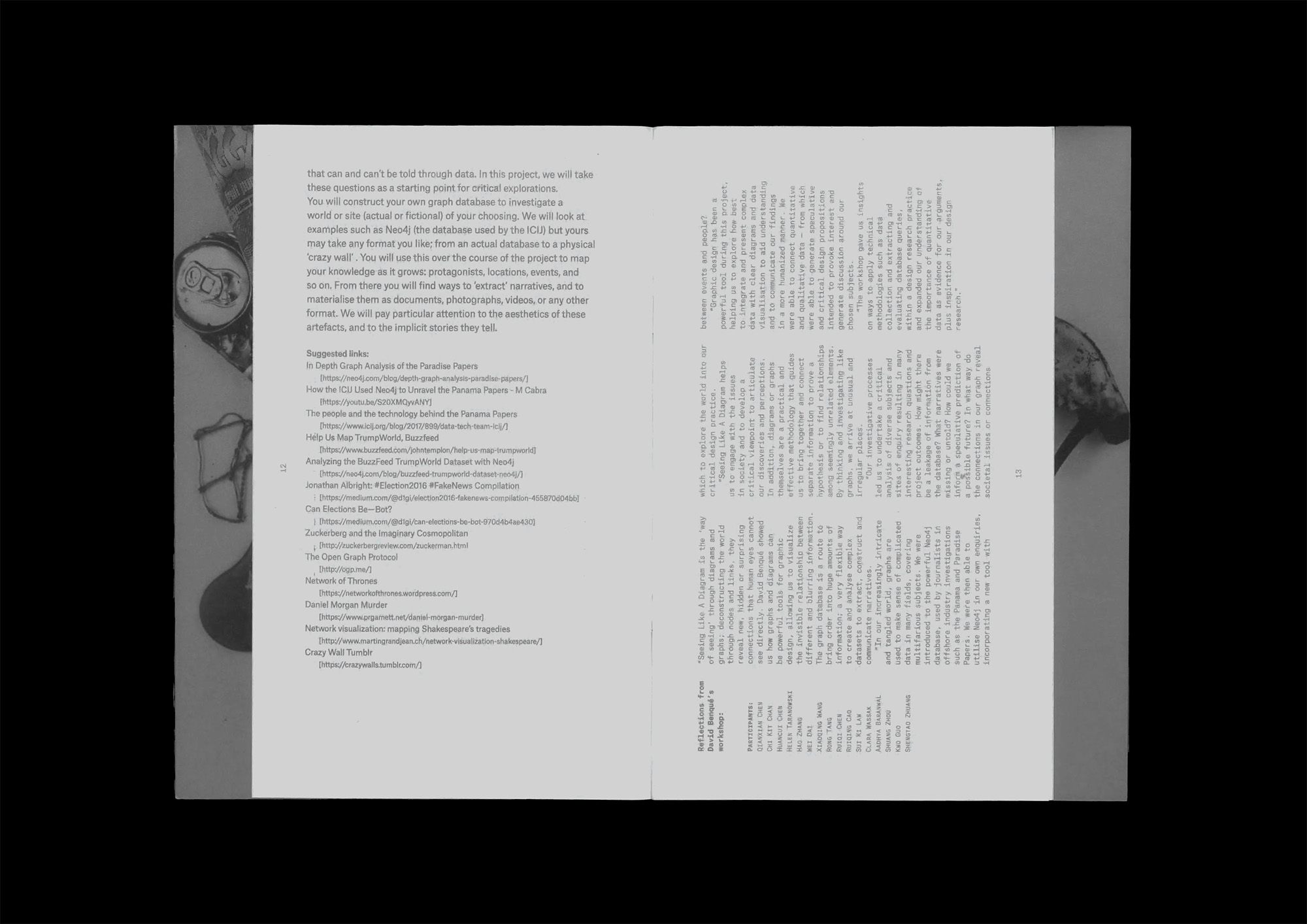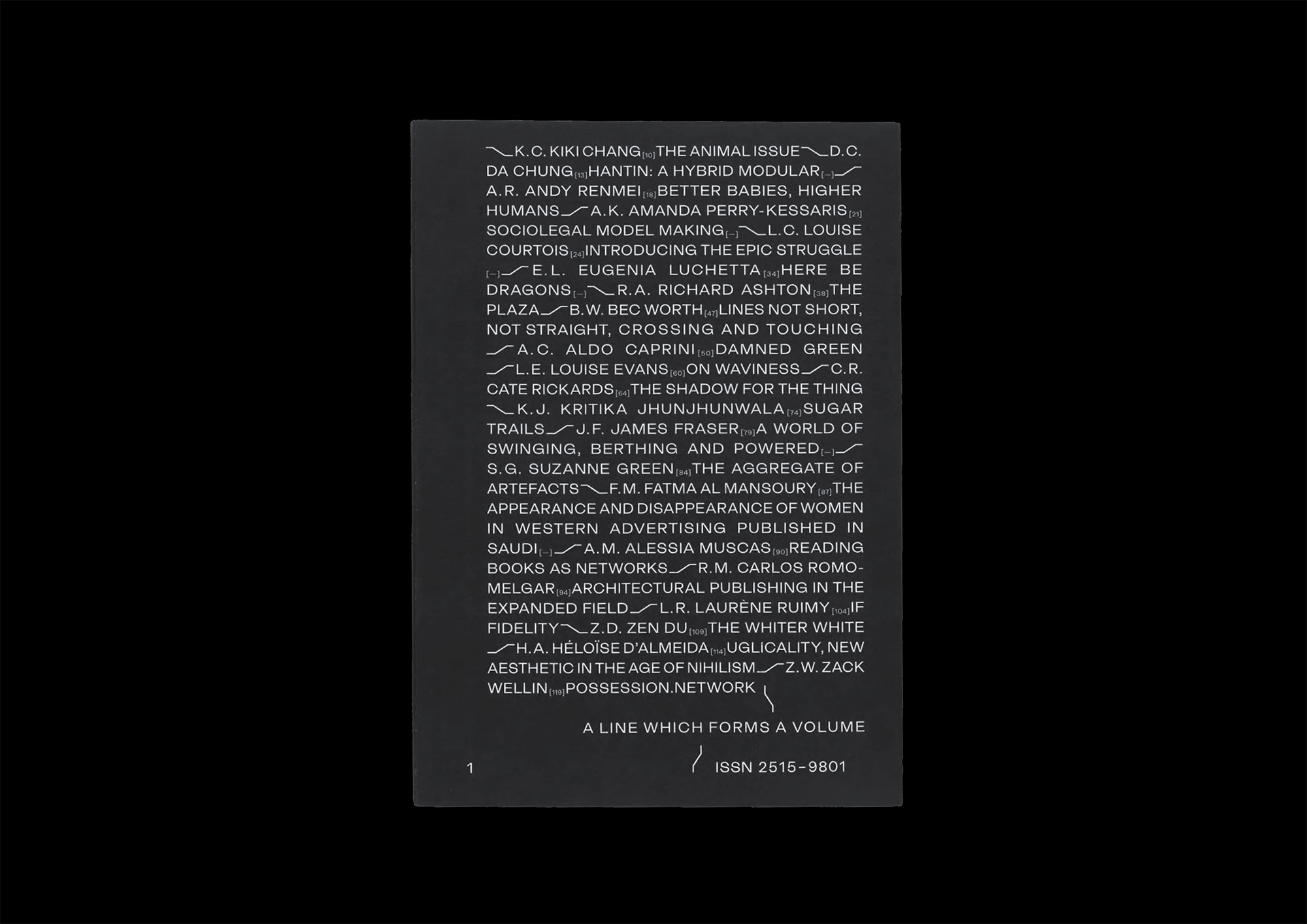A Line Which Forms a Volume 8
A Line Which Forms a Volume 8 explores the concept of ‘refraction’ as a means of facilitating and understanding design, research and collaboration. We use the lens of refraction to expand beyond institutional frames and their restrictions, embracing the changes and shifts in our understanding of graphic design, design education, and design discourse – focusing on how knowledge and experiences can be fragmented and redirected for greater understanding. This issue starts from a straight line to the refraction of multiple pathways which are choreographed within the publication’s format.
Advisor: Irene Sempere
ALWFAV Team: Aditi Sharma, Gunesh Garibli, Hanyu Yang, Kealani Espinda, Wang Li-Ting, Aastha Chauhan, Ge Gan, Jiayi Gu, Jingping Jiang, Juyi Wang, Olivia Zuo, Regina González Rossi, Runbin Xiao, Sadie Lee, Shreya Joshi, Sruthi Nair, Lauren Housden, Bethany Faulkner
Author: MA GMD 2024-25 cohort
Language: English
Size: 160 x 190 mm; 152 pages
Edition: 500
Year: 2025
Price: GBP 8.00
Order here
How We Read
How We Read is a companion guide to the literature resources shared with participants as part of the MA GMD programme. It compiles a series of comparative reviews showcasing initial reactions from participants to the texts they read in the course's Literature Review series. The book serves as frame of reference for upcoming students, and as a reminder of the shifting positions that readers have while navigating the course.
Editors: Evie McNulty, Ge Gan, Lauren Housden, Sruthi Nair
Author: MA GMD 2023-24 cohort
Language: English
Size: 150 x 230 mm
Edition: POD
Year: 2024
Price: GBP 15.00
Order here
A Line Which Forms A Volume 7
A Line Which Forms a Volume 7 aims to build the ‘networked structure of feeling’ where it documents and explores the role of emotions in the process of design research.
By unravelling the emotions embedded in the processes of design research, the seventh volume opens the gate to a ‘discursive space where stories can be told’: allowing affective interpretations and connections to spread and extend through the issue, to the public. It serves as a platform that promotes emotional readings and affective processes through visual prompts but also intricately weaves together the diverse subjects within its network.
Advisors: Paloma Moniz & Ricardo Gonçalves
ALWFAV Team: Chengbo Yao, Yang Sun, Cheng Chang, Sea Ho, Yankai Pei, Pauline Hill, Hyowon Choi, Huazheng Wang, Maja Rohde, Suting Chen
Author: MA GMD 2022-23 cohort
Language: English
Size: 160 x 190 mm, 162 pages
Edition: 400
Year: 2024
Price: GBP 7.50
Order here
Download PDF
Way Out: Visual Journeys Through London
A risographed zine documenting the role of collecting on a journey through London
Workshop Lead: Mark Pawson & Tony Credland
Authors: Shiming Liang, Hyowon Choi, Sang Bao, Zibo Cheng, Muskaan Soni, Maja Rohde, Yi Lin Eng, Wenhui Wu, Shuman Ran, Qian Xie, Kexin Huang & Jing Wang.
Language: English
Size: 30x30 cm, 28 pages
Edition: 120
Year: 2023
Price: £5
Order here
The Language of Print 1
Description: The series of experimental imagery, presented in this project serves as a reflection between the symbiotic relationship between London College of Communication and the language of print. This gives way to a project that highlights the visual aspects of print machinery, Placing a focus on intricate details sourced from diagrams found in archival manuals, through the use of colour and layering made possible by offset litho.
Workshop Lead: Daniel Fletcher & Tony Credland
Authors: Aisha Maccido, Alexa Nikolova, Chuyan Sheng, Montserrat Bao Quiero, Misra Uzun, Pauline Hill, Pin Lee, Sea Ho, Shreya Tawade & Yan Ji.
Language: English
Size: 16x24 cm, 28 pages
Edition: 250
Year: 2023
Price: £5
Order here
A Line Which Forms A Volume 6
A Line Which Forms a Volume 6 reviews the mycorrhizal fungi network as a conceptual theme to view the interconnection that builds knowledge. Through the publication, it explores and materialises the network of knowledge the previous volumes produced throughout the years, making design research visible. Here, like the fungi, knowledge is intertwined together, building the thread bigger and stronger.
The sixth volume serves as a source of truth where research methodologies, processes and outcomes come together. It explores the connections and relations that have grown through ALWFAV, as the annual-critical readers, celebrating the legacy that has been built.
Advisors: spreeeng (Carlos Romo-Melgar & John Philip Sage)
ALWFAV Team: Paola Sánchez, Yuxin Xiong, Anqi Meng, Yuhao Chen, Qinyi Yang, Ben Conod, Kexin Zhang, Xiaotong Liang, Junchen Jin
Author: MA GMD 2021-22 cohort
Language: English
Size: 160 x 190 mm, 144 pages
Edition: 500
Year: 2023
Price: GBP 7.50
Order here
Download PDF
A Line Which Forms A Volume 5
A Line Which Forms a Volume 5 explores acts of leaning, seeking shared stability and collaboration. It views leaning as encounters between care and radical transparency in design research. It defies integrity through leaning and lets vulnerability arise: exercising care for the complexities of the complicated society.
Using graphic design as a critical tool for investigations and divulgation, the fifth volume builds physical and conceptual support structures. This provides the public with a route into the research areas it is contributing to. As design practitioners, the participants claim that their practices lean on, through, into and towards a subject.
Advisors: Open Practice (Gabriela Matuszyk & Katie Evans)
ALWFAV Team: Amy Henry, Dasha Lugovkin, Ghia El Koussa, Ilaria Golin, Jaeeun Bia Lee, Reuxn Xin Yao, Sarah Støle, Victoire Colliou, Wendy Xiuwen Chen, Yuan Gu
Author: MA GMD 2020-21 cohort
Language: English
Size: 100 x 210 mm, 162 pages
Edition: 977
Year: 2021
Price: GBP 7.50
Order here
Download PDF
A Line Which Forms A Volume 4
A Line Which Forms a Volume 4 approaches design decoloniality by reflecting on the constructed borders of the design canon. Looking at the volume as a territory, it focuses on the possibilities of design practices to move and cross borders. By ‘tilting’ the dominant axis of direction, the publication embarks upon a journey that goes ‘out of lines’, in an attempt to share, open and expand the conversations around design research.
The fourth volume brings contributions from Ahmed Ansari, Clara Balaguer, Yu Jiwon, Lucas Larochelle, Paul Bailey, Tony Credland, and the MA GMD participants.
Advisors: Of Common Interest (Nina Paim & Eliot C. Gisel)
ALWFAV Team: Alex Kim, Rachel Jung, Rhys Atkinson, Riccardo Righi, Yao Qi, Zhu Yiting
Author: MA GMD 2019-20 cohort
Language: English
Size: 116 x 186 mm, 144 pages
Edition: 950
Year: 2020
Price: GBP 7.50
Order here
Download PDF
A Line Which Forms A Volume 3
A Line Which Forms a Volume 3 embodies the critical nature of design research through the metaphor of roundabouts: a space that integrates multiple perspectives, generating an environment of cooperation and community. The volume fosters collaboration, cultivating a network of interdependence, enabling the development of community rooted in the MA Graphic Media Design course.
The reader is guided by notions such as order and chaos, crash, intersection, interrupted continuity, temporary occupation and the idea of stepping in and stepping out. The volume intends to create a continuous reading flow with no visual hierarchy, but a distinct dialogue between the contributions.
Author: MA GMD (Cohort 2018–19)
ALWFAV Team: Francisca Roseiro, Jaime del Corro, Laura Dirzyte, Margarida Morais, Martin Stesko, Paloma Moniz, Ricardo Gonçalves, Roxy Zeiher
Language: English
Size: 123 x 158 cm, 168 pages
Edition: 1000
Year: 2019
Price: £7
Order here
Download PDF
Positioning Practice 3: The Reciprocal Studio: On Distraction
This third issue of Positioning Practice presents The Reciprocal Studio: On Distraction, four collaborative workshops instigated by MA GMD at LCC in January 2019. Each workshop approached concerns of distraction from distinct starting points and research methods, guided by guests FRAUD (Audrey Samson & Francisco Gallardo), Confusion of Tongues (Marthe Prins & Benedict Waishaupt), Demystification Committee (Oliver Smith & Francesco Tacchini) and Francisco Laranjo (Modes of Criticism). Participants were invited to work with learning and teaching models based on reciprocity — to use this collaborative working period as a moment to collectively investigate through the procedures of a research-oriented graphic design practice.
Published by Graphic Design Research
Design: Laura Dirzyte, Naomi Strinati, Ying Ye, Zhenqi Liu, Rong Lian, Shuting Wen, Yunjing Li, Fangxinran Guo, Martin Stesko, Jia Xiao, Jiatai Tian.
Co-ordinated by Paul Bailey and Tony Credland.
Workshop Leaders: FRAUD, Confusion of Tongues, Demystification Committee, and Francisco Laranjo.
Participants: 2019 MA GMD cohort.
Size: 170 x 240 mm / 32 pages
Edition: 500
Year: 2019
Price: £5
Order here
A Line Which Forms A Volume 2
The second issue of A Line Which Forms a Volume brings lines of design inquiry to form a multidirectional network. Continuously and simultaneously, they represent a multiplicity of individual strands that extend and multiply in response to the field of design research and publishing.
Graduating participants, Ruiqing Cao, Katie Evans, Gabriela Matuszyk, Núria Pla Cid and Cristina Rosique Gómez, presented abstracts from their research. They spoke alongside guest speakers, Gavin Wade and Peter Nencini, who informed the lines of participant inquiry and also contributed to the publication, situating emergent research within the wider scope of design discourse and publishing.
Advisor: Matthew Stuart
ALWFAV Team: Aadhya Baranwal, Clara Wassak, Clare Larsen–Burnett, Cristina Rosique, Jaya Modi, Kwo Guo, Lan Le, Núria Pla Cid, Rong Tang, Shengtao Zhuang, Virginia Christakos, Xiaoqing Wang, Ya-han Liang
Author: MA GMD 2017-18 cohort
Language: English
Size: 120 x 200 mm, 164 pages
Edition: 700
Year: 2018
Sold Out
Download PDF
Positioning Practice 2: (Re)distributed Media: Leakage
This second issue of Positioning Practice titled (Re)distributed Media: Leakage – a set of four collaborative workshops devised by the MAGMD course, that took place at LCC/UAL in 2018, run by Audrey Samson and Francisco Gallardo (FRAUD), Ruben Pater, Marwan Kaabour and David Benqué, later extended to formulate a weekend long public programme for the Hope to Nope: Graphics & Politics 2008-2018 exhibition at the Design Museum, London (June 2018). Asking how do we navigate increasingly polluted information-scapes? Who are the gate-keepers of news, opinion, policy and why and how we can challenge the distribution of information from positions of power?
Published by Graphic Design Research
Editors: Tony Credland, Paul Bailey, with MA GMD participants
Workshop Leaders: Audrey Samson and Francisco Gallardo (FRAUD), Ruben Pater, Marwan Kaabour and David Benqué
Size: 170 x 240 mm / 32 pages
Edition: 500
Year: 2018
Price: £5
Order here
A Line Which Forms A Volume 1
A Line of critical inquiry is a dynamic, ever-evolving thread. Representing questions, conversations, and responses, it constantly reshapes itself in response to the context in which graphic design exists. A Volume, both a tangible object and an audible moment, is a space that projects and disseminates ideas. It is an opportunity to share research in a wider context of design criticism and publishing.
A Line Which Forms a Volume is an annual critical reader of graphic design-led research that is authored, edited, designed and made public by MA Graphic Media Design participants. It brings together narrative, messages and meanings.
Advisors: Wayne Daly & Clarie Lyon
ALWFAV Team: Aldo Caprini, Bec Worth, Carlos Romo-Melgar, Cate Rickards, Clare Larsen–Burnett, Gabriela Matuszyk, Héloïse d’Almeida, Katie Evans, Kritika Jhunjhunwala, Laurène Ruimy, Louise Evans, Richard Ashton, Zack Wellin, Zen Du
Author: MA GMD 2016-17 cohort
Language: English
Size: 103 x 145 mm, 144 pages
Edition: 700
Year: 2017
Sold Out
Download PDF
Positioning Practice 1: Staging the Message
Introducing wide-ranging research workshops from within the MA GMD course, Positioning Practice considers how the intentionality, methodology and theoretical framing offered by this learning and teaching model can provide examples of practice operating as research. This first issue of Positioning Practice discusses Staging the Message, a five day collaborative workshop given by Els Kuipers and Jan van Toorn at LCC. The cross cultural, multidisciplinary workshop included postgraduate and PhD participants from seven nationalities with design backgrounds. Participants developed visual essays studying the ‘dialogic’ message, encouraging intentionally nonlinear, unclear, and unfinished interaction with the reader through design.
Published by Graphic Design Research
Editors: Tony Credland, Vanessa Price.
Workshop Leaders: Jan van Toorn & Els Kuijpers,
Participants: Olivia Williams, Sarah Wick, Bec Worth, Tzortzis Rallis, Nadav Barkan, Carla Houston, Cat Drew, Laurie Jackson, Callum Houldsworth, Valeria Conti, Matteo Basato, Rallou Mylona.
Design: Matteo Bisato & Tzortzis Rallis
Language: English
Size: 170 x 240 mm / 32 pages
Edition: 500
Year: 2016
Price: £5
Order here
THE ROLLING DRUM
ABOUT
The Rolling Drum is an online platform with the purpose of disseminating publications developed by participants of the MA Graphic Media Design course at LCC, UAL, by offering a contact point with individual authors. Initiated by the MA GMD 2021 cohort and passed on in subsequent years, the PRESS has three purposes. The first is the distribution of course material – A Line Which Forms a Volume, along with newsletters and Positioning Practice publications. Secondly, the PRESS is a space for publishing experimental outputs from course workshops, and lastly it provides a location for connecting alumni to a wider audience, presenting multiples of their final outcomes alongside future publications.
MA Graphic Media Design
London College of Communication
Elephant and Castle
London SE1 6SB
United Kingdom
therollingdrum@gmail.com
DISCLAIMER
This platform is a point to connect with the course and individual authors to order items, as we’re unable to offer transactions directly through the site at this time. Kindly note that we cannot take responsibility for payments or transactions with individual contributors. If you have any queries, please send us an email.
CONTRIBUTIONS
We accept contributions to this platform from current MA GMD participants and alumni. If you are interested in featuring your publications on this website, please fill in the form with the required information. We will review contributions every quarter and provide a response as soon as possible.
Please be aware that our website is operated by dedicated volunteers. While we strive to answer promptly, the timing of our responses may vary. We appreciate your understanding and patience.
More information about contributions here















